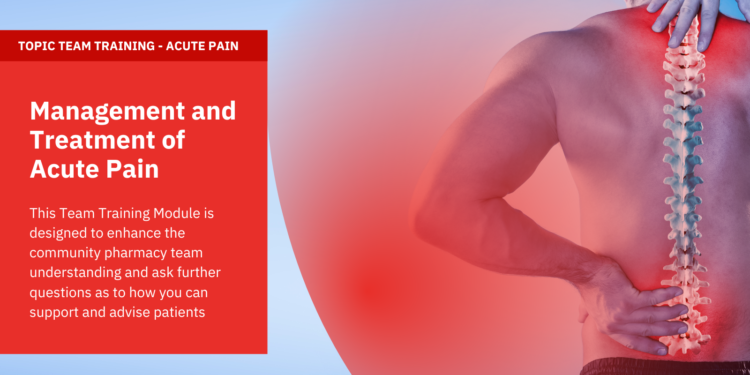A community pharmacy environment that fosters teamwork ensures high levels of consumer satisfaction. This series of articles is designed for you to use as a guide to assist your team in focusing on meeting ongoing CPD targets and to identify any training needs in order to keep the knowledge and skills of you and your team up to date.
Following on from the October issue Continuing Professional Development on the Management and Treatment of Acute Pain, this Team Training Module is designed to enhance the community pharmacy team understanding and ask further questions as to how you can support and advise patients.
Pain is a distressing sensation, as well as an emotional experience. The International Association for the Study of Pain (IASP) defines pain as an unpleasant sensory and emotional experience associated with, or resembling that associated with, actual or potential tissue damage.
In pain perception, three main stages generally occur, firstly pain sensitivity, then pain transmission from the periphery to the DH, and finally, transmission of these signals to the higher brain, e.g cortex, through nerves in the central nervous system (CNS).
- Transduction occurs initially. The painful stimulus is converted to chemical tissue events, then chemical tissue and synaptic cleft events are converted into electrical events in the neurons, and finally electrical events in neurons are transduced as chemical events in the synapses.
- Transmission then occurs, i.e. the propagation of electrical events along the neuronal pathways and across synapses.
- Modulation then takes place at all levels of nociceptive pathways through the primary afferent neuron, DH and higher brain centres, up or downregulating the sensation.
Pain can be grouped into three different classifications: nociceptive, neuropathic, and inflammatory:
Nociceptive: Aδ and C-fibres are mostly found in superficial organs, such as the skin, whereas deeper structures such as muscles and joints are mainly supplied with C-fibres. There is an additional nociceptor type called silent nociceptors. These are located in the viscera and are usually insensitive to mechanical stimuli, but can be sensitised by the chemical mediators produced during inflammatory reactions.
Neuropathic: this type of pain generally serves no purpose. It is commonly described as nerve injury or impairment and is associated with allodynia (central pain sensitisation). Nerve neurochemistry can be damaged after compression, stretching, or hyperexcitability propagated from other peripheral nerves.
Inflammatory: This is a normal biological response to harmful stimuli that is required to start tissue repair. Neutrophils are usually the first cells to gather at the site of injury. Redness and swelling at the site of injury is due to the increased blood flow and increased vascular permeability, which can also induce pain.
Pain is strongly associated with self-care management and acute pain is responsible for consumption of large quantities of over the counter (OTC) non-steroidal antiinflammatory drugs (NSAIDS).
The aims of pain management should be discussed with each individual, but may include some or all of the following:
- Reducing the intensity of pain
- Enhancing physical functioning
- Improving psychological functioning
- Promoting return to work or school and/or role within family and society
- Improving health-related quality of life
A Cochrane review investigating the effects of analgesics/analgesic combinations (given as single doses postoperatively) concluded that there is evidence supporting the efficacy of these OTC drugs that are available without prescription, with ADRs generally not different from placebo.
Paracetamol is a great first line choice for mild to moderate pain. It has no known GI, renal or cardiac adverse effects at the usual OTC and prescribed doses; however, the patient should be reminded of the maximum daily dose over 24 hours to reduce the risk of accidentally exceeding this.
Codeine and paracetamol combination products should only be offered for e.g. managing acute lower back pain if an NSAID is not suitable or has been ineffective.
Caffeine does not have any pain relieving effect itself, but rather is added as an adjuvant to ibuprofen, aspirin and/or paracetamol products to enhance their analgesic effects.
The most effective OTC drugs used were ibuprofen/ paracetamol combinations in 400mg/1,000mg and 200mg/500mg doses; respectively, providing relief to 70% of people, and with a NNT of less than 2.
Consider:
- Is the pharmacy team fully trained on the indications and benefits of all products for the treatment of acute pain?
- How are pain relief products (oral and topical) displayed in the pharmacy?
• Do we make the most of the potential for linked sales (e.g. oral and topical analgesics, food supplements, complementary therapies, support bandages)
• Am I up to date with the latest guidance?
• Am I aware which preparations are recommended first-line?
Key Points:
• The causes of acute pain, including the various types of injury
• What types of pain can be considered for management in the pharmacy
• Which customers should be referred to the pharmacist
• The importance of not taking certain oral analgesics for longer than three days without referral
• Questions to ask the customer
Actions:
Ensure support staff understand the following key points:
• The common types of acute pain
• The characteristics of a good analgesic for OTC use in the treatment of acute pain
• The benefits and limitations of OTC medicines
• The importance of what outcome a patient presenting with pain wants
• Lifestyle issues that may impact on pain recovery, and tips on improving lifestyle
• What approaches are recommended by the World Health Organisation (WHO) analgesic ladder
• When to refer customers to the pharmacist.

View the November Magazine HERE









